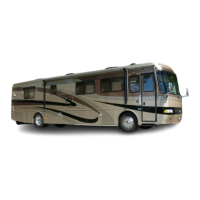The correct wheel alignment pro-
motes longer tire wear and ease of
handling while minimizing the strain
on the steering system and the axle
components.
Camber:
Camber, as shown below, is verti-
cal tilt of wheel as viewed from the
front of the vehicle. This is machined
into the axle when manufactured and
is not adjustable.
• “Positive” camber is an outward tilt
of the wheel at the top.
• “Negative” camber is an inward tilt
of the wheel at the top.
Toe Setting:
The toe setting represents differ-
ent distances between the front and
rear of the tires (measured at the ver-
tical centerline of the tires).
Toe-in occurs when the tire front
distance is less than the tire rear dis-
tance.
Toe-out occurs when the tire front
distance is greater than the tire rear
distance.
Wheels are generally set with ini-
tial toe-in. As the vehicle operates,
tires tend toward a toe-out condition.
By starting with an initial toe-in set-
ting a desirable “near zero toe-in” can
be achieved when the vehicle is in
motion.
Incorrect toe settings, where toed-
in or toed-out, can have a significant
effect on tire wear. The toe setting is
adjusted by lengthening or shortening
the cross tube.
The toe setting is .03 degree.
Chassis Information
---------------------------------------------------------------------------------------------------------------------------------------------------------------------------------------------------------------------------------------------------------------------------------------------------------------------
WINDSOR
10•270
ALIGNMENT SPECIFICATIONS

